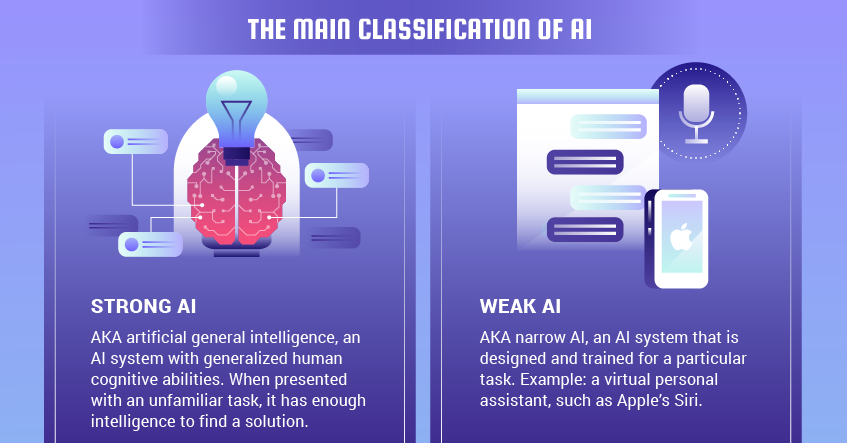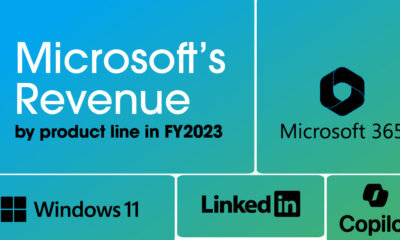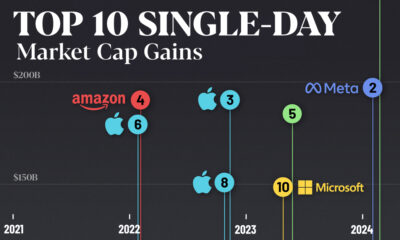Technology
Visualizing the AI Revolution in One Infographic
Science fiction didn’t do a great job in preparing us for our first real encounters with AI.
Most people probably still envision AI in the form of a sentient robot that can talk, move around, and experience feelings – something like WALL-E or C-3PO from the movies.
Although that still may be the dream, it turns out that the current iteration of AI is actually quite different. With modern AI, all the “thinking” gets done in the cloud, and the algorithms aren’t tied to the identity of a physical machine like we would have expected from the big screen.
The modern iteration of AI works silently in the background without a face, and it’s starting to impact everything it touches. It’s also set to transform our economy at warp speed.
Putting Modern AI Into Context
Today’s infographic from TechJury helps you understand the context around this emerging force.
Entitled “The AI Revolution”, it covers the brief history of AI, the industries that will be affected, as well as some key AI statistics that are likely to catch your eye.

Note: The infographic references a chatbot named Eugene Goostman that allegedly passed the Turing Test in 2014. Please note that this is a very contentious claim: while it did fool 33% of judges that it was a human, many experts object to the claim for a wide variety of reasons.
Artificial intelligence is here and it’s transforming our economy.
One estimate by PwC puts the global impact of AI at $15.7 trillion by 2030, while Accenture says that AI could double the rate of economic growth in developed countries by 2035.
If either of these two predictions come true, it will mean big change for almost every industry.
The AI Revolution: By the Numbers
What does it look like when AI takes the world be storm?
The following stats will give you an indication on the potential impact of the AI revolution, and how it’s already shaping the future of business thinking:
- The number of AI startups has increased 14x since the year 2000
- The amount of investment in AI startups has increased 6x since 2000
- 15% of enterprises in 2018 already use AI, but 31% more will come on board in the next 12 months
- 72% of executives see AI as being the most significant future business advantage
- 84% of global businesses see AI as providing a competitive advantage
- 41% of consumers believe AI will improve their lives in some way
- By 2020, businesses using AI to drive consumer insights will see $1.2 trillion more per year than their less-informed competitors
So while the AI revolution is not led by the identifiable face of a friendly (or antagonistic) robot in a physical form, experts agree that impact of AI on business will be profound.
See how the prevailing myths about AI in the workplace have been debunked, to learn even more on the subject.
Brands
How Tech Logos Have Evolved Over Time
From complete overhauls to more subtle tweaks, these tech logos have had quite a journey. Featuring: Google, Apple, and more.

How Tech Logos Have Evolved Over Time
This was originally posted on our Voronoi app. Download the app for free on iOS or Android and discover incredible data-driven charts from a variety of trusted sources.
One would be hard-pressed to find a company that has never changed its logo. Granted, some brands—like Rolex, IBM, and Coca-Cola—tend to just have more minimalistic updates. But other companies undergo an entire identity change, thus necessitating a full overhaul.
In this graphic, we visualized the evolution of prominent tech companies’ logos over time. All of these brands ranked highly in a Q1 2024 YouGov study of America’s most famous tech brands. The logo changes are sourced from 1000logos.net.
How Many Times Has Google Changed Its Logo?
Google and Facebook share a 98% fame rating according to YouGov. But while Facebook’s rise was captured in The Social Network (2010), Google’s history tends to be a little less lionized in popular culture.
For example, Google was initially called “Backrub” because it analyzed “back links” to understand how important a website was. Since its founding, Google has undergone eight logo changes, finally settling on its current one in 2015.
| Company | Number of Logo Changes |
|---|---|
| 8 | |
| HP | 8 |
| Amazon | 6 |
| Microsoft | 6 |
| Samsung | 6 |
| Apple | 5* |
Note: *Includes color changes. Source: 1000Logos.net
Another fun origin story is Microsoft, which started off as Traf-O-Data, a traffic counter reading company that generated reports for traffic engineers. By 1975, the company was renamed. But it wasn’t until 2012 that Microsoft put the iconic Windows logo—still the most popular desktop operating system—alongside its name.
And then there’s Samsung, which started as a grocery trading store in 1938. Its pivot to electronics started in the 1970s with black and white television sets. For 55 years, the company kept some form of stars from its first logo, until 1993, when the iconic encircled blue Samsung logo debuted.
Finally, Apple’s first logo in 1976 featured Isaac Newton reading under a tree—moments before an apple fell on his head. Two years later, the iconic bitten apple logo would be designed at Steve Jobs’ behest, and it would take another two decades for it to go monochrome.
-

 Green1 week ago
Green1 week agoRanked: The Countries With the Most Air Pollution in 2023
-

 Automotive2 weeks ago
Automotive2 weeks agoAlmost Every EV Stock is Down After Q1 2024
-

 AI2 weeks ago
AI2 weeks agoThe Stock Performance of U.S. Chipmakers So Far in 2024
-

 Markets2 weeks ago
Markets2 weeks agoCharted: Big Four Market Share by S&P 500 Audits
-

 Real Estate2 weeks ago
Real Estate2 weeks agoRanked: The Most Valuable Housing Markets in America
-

 Money2 weeks ago
Money2 weeks agoWhich States Have the Highest Minimum Wage in America?
-

 AI2 weeks ago
AI2 weeks agoRanked: Semiconductor Companies by Industry Revenue Share
-

 Travel2 weeks ago
Travel2 weeks agoRanked: The World’s Top Flight Routes, by Revenue















